NYC Sewer System
Learn about the history of NYC's sewer system, how it functions, and its importance to human and ecosystem health.

Before New York City transformed into the bustling metropolis we know today, it was a lush, green landscape. With changes to both the land and population came many challenges, like managing our water resources. Just as we developed a drinking water supply to ensure the health of residents, we also needed to develop ways to dispose of our waste. Let's explore how we built an effective system to collect our waste and ensure clean water is returned safely to the environment. Download the Student Worksheet to follow along.


History of the NYC Sewer System
By the early 1800s, NYC's population was rapidly increasing. More people meant more waste to clean up. Increased development also meant that impervious surfaces covered much of the natural landscape, creating excess water runoff each time it rained. Due to growing unsanitary conditions and threats to public health and the local ecosystem, it became clear that we needed to build a sewer system to collect our wastewater and stormwater runoff.
NYC's Sewer System Today
Today, we manage a complex system of sewer pipes, catch basins, and pumping stations, that collect and carry our wastewater and stormwater runoff. To learn more about the wastewater treatment process, visit the Wastewater Treatment Virtual Tour.
Continue reading to find out how wastewater and stormwater are transported through the sewer system.
Protecting Our Sewers
Given the variety of waste that can end up in our sewers, some items can cause more damage than others. For example, fatbergs, a mixture of grease, wet wipes, and other household waste products can form in our sewer pipes and interrupt the flow of wastewater. View the slideshow below to find out how we inspect and maintain the sewer system.
How can you help?
As you've just learned, the NYC Department of Environmental Protection works to maintain and improve our sewer system. However, we can all work together to protect our sewers. Continue reading to learn how you can help.
Trash It. Don't Flush It.
Trash It. Don't Flush It.
When we flush or drain household waste, like cooking grease and wet wipes, we can end up clogging our pipes and the sewers beneath our street. Remember that these clogs, or fatbergs, can cause sewer back-ups and damage to our sewer system.
Watch the video to find out which types of waste can be flushed, and which should be trashed.
Don't Trash Our Waters
Keep Our Waters Trash-Free
When it rains, stormwater runoff picks up litter and other contaminants on streets and sidewalks and flows into the sewers. Such trash can clog catch basins and cause street flooding. Polluted stormwater can also end up flowing directly to our waterways untreated. Help protect our sewers and New York Harbor by recycling when possible and throwing litter in trash cans.
Activities and Resources
Check out some of the activities and resources below to continue learning about NYC's sewer system and how we can all help it function properly.
- What is a watershed? Simply put, a watershed is an area of land that collects water. We all live in a watershed, even in NYC! Use this activity to think about the ways water drains in NYC, into the sewers and into waterways.
- Explore the watershed in your own neighborhood, and compare it to the landscape of our drinking watersheds.
- Complete the Secrets of the Sewers Worksheet, while you watch the Secrets of New York episode below about the sewers and wastewater treatment system.
NYC Media
For more activities and resources, visit DEP's website and the Sewer System Education Module .
Glossary
Combined Sewer Overflow (CSO) - A mix of excess stormwater runoff and untreated wastewater that discharges from combined sewers to waterways. CSOs generally occur during heavy rain or snowmelt when wastewater resource recovery facilities reach capacity.
Combined sewer system - A sewer system designed to collect and carry wastewater and stormwater runoff together to wastewater resource recovery facilities.
Fatberg - A combination of the words “fat” and “iceberg” to describe the masses of congealed grease and personal hygiene products that can clog sewer pipes and damage wastewater treatment equipment.
Impervious surface - A surface, or an area, which water cannot seep in or pass through.
Municipal Separate Storm Sewer System (MS4) - A sewer system that collects stormwater runoff from properties and streets, and discharges it directly to surrounding waterways.
Sewer - A pipe or conduit that carries wastewater and stormwater from the source to a treatment facility or receiving waterway.
Separate sewer system - A sewer system designed to collect wastewater and stormwater runoff separately, carrying wastewater to wastewater resource recovery facilities and stormwater runoff directly to waterways.
Stormwater runoff - The precipitation that falls on streets, sidewalks, and rooftops and flows overland, rather than being absorbed naturally into the ground.
Wastewater - The used water mixed with solid waste that flows down the drains from homes, schools, and businesses. Also referred to as "sewage."
We encourage you to check out more NYC Water Virtual Tours . We would also love to hear from you, please take a moment to share your feedback on our virtual tours.